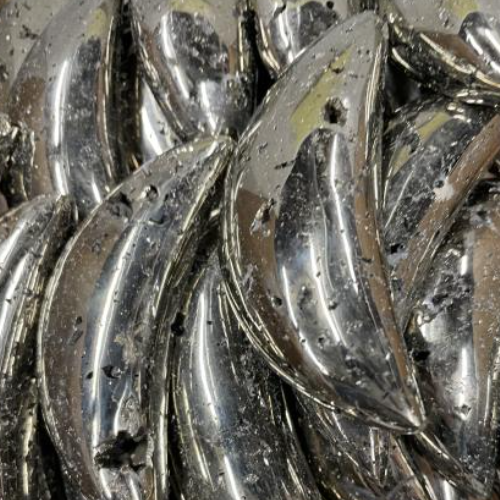Product Description
Pyrite w/ Druze Crescent Moon Carving 4"x1.25"
Mineral Information:
Pyrite is a mineral that is also known as "fool's gold" due to its resemblance to gold. It is composed of iron disulfide (FeS2) and is one of the most common sulfide minerals found in the Earth's crust. Here are some key features and characteristics of pyrite:
-
Appearance: Pyrite has a brassy yellow color and a metallic luster, giving it a shiny and reflective appearance. It often forms in cubic or octahedral crystal shapes, but it can also be found as masses or in irregular shapes.
-
Hardness: Pyrite has a hardness of 6 to 6.5 on the Mohs scale, which means it is relatively hard and can scratch glass. However, it is still softer than many other minerals commonly used in jewelry.
-
Formation: Pyrite forms in a variety of geological environments, including sedimentary rocks, hydrothermal veins, and metamorphic rocks. It is often found alongside other minerals such as quartz, calcite, and marcasite. Pyrite crystals can grow in a variety of sizes, from microscopic to large, impressive formations.
-
Properties: Pyrite is known for its metallic luster and high density. It has a cubic crystal structure and exhibits a distinctive cleavage pattern, meaning it breaks along specific planes with smooth, flat surfaces. Pyrite is also highly brittle, meaning it can break or crumble easily if subjected to force or pressure.
-
Uses: Historically, pyrite was mistaken for gold and has been used as a source of sulfur and in the production of sulfuric acid. In modern times, it is primarily used as a decorative mineral and in the production of jewelry, beads, and ornamental objects. Pyrite specimens are also collected by mineral enthusiasts for their unique crystal forms and metallic shine.
It's important to note that while pyrite has its own unique beauty and properties, it can oxidize and tarnish over time when exposed to air and moisture. This can result in a change in color and a formation of a powdery substance called iron oxide. To maintain the appearance of pyrite, it is best to store it in a dry and protected environment.
Metaphysical Meaning:
Pyrite is associated with abundance, prosperity, and manifestation. It is believed to enhance willpower, confidence, and creativity, and to promote positive energy and protection against negativity. Pyrite is often used in crystal healing practices to stimulate the solar plexus chakra and increase vitality and motivation.
Mineral Care:
Pyrite, despite its appearance, is a relatively fragile mineral. While it may have a metallic and solid appearance, it can be prone to breakage and damage under certain conditions. Here are some factors that contribute to the fragility of pyrite:
-
Cleavage: Pyrite exhibits a distinct cubic cleavage, meaning it tends to break along specific planes. If external force is applied in the direction of these cleavage planes, pyrite can easily split or fracture. This can result in the formation of irregular or uneven surfaces, diminishing the integrity of the mineral.
-
Brittleness: Pyrite is considered a brittle mineral. Brittle materials are characterized by a lack of flexibility and resistance to deformation. When subjected to pressure or impact, pyrite is more likely to fracture or crumble rather than bend or deform.
-
Oxidation: Pyrite is susceptible to oxidation, which refers to the reaction of the mineral with oxygen in the presence of moisture or air. Over time, pyrite can undergo a process known as "pyrite disease" or "pyrite decay." This involves the formation of iron oxide and other byproducts, resulting in a breakdown of the pyrite structure and potential crumbling or disintegration.
-
Environmental Sensitivity: Pyrite can be sensitive to environmental conditions. It is prone to deterioration when exposed to high humidity, moisture, and acidic environments. These conditions can accelerate the oxidation process, leading to the degradation of pyrite's structural integrity.
To care for pyrite and minimize the risk of damage:
- Handle pyrite with care, avoiding excessive force or impact that could cause fractures or breakage.
- Protect pyrite from exposure to moisture and humidity, as prolonged contact can contribute to oxidation and deterioration.
- Store pyrite in a dry environment, preferably in a protective container or pouch to prevent contact with other minerals or objects that could potentially scratch or damage it.
- Avoid cleaning pyrite with harsh chemicals or abrasive materials, as they can cause further damage or accelerate the oxidation process. Instead, gently clean pyrite with a soft brush or cloth.
Disclaimer:
No information here is intended to diagnose, treat or cure ailments or afflictions of any kind. One should always consult a medical professional if a serious issue presents itself.






